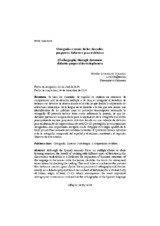Mostrar el registro sencillo del ítem
Ortografía a través de los dictados: propuesta didáctica para italófonos
| dc.contributor.author | González Vallejo, Rubén | |
| dc.date.accessioned | 2020-05-27T12:08:35Z | |
| dc.date.available | 2020-05-27T12:08:35Z | |
| dc.date.issued | 2019 | |
| dc.identifier.issn | 2386-9658 | |
| dc.identifier.uri | http://hdl.handle.net/10396/20025 | |
| dc.description.abstract | Si bien los manuales de español se centran en ejercicios de comprensión oral de elección múltiple o de cloze, es innegable el beneficio de trabajar con dictados de diversa índole en el aula, ya que facilita la adquisición de estructuras semánticas de la lengua en el discente a la vez que este realiza una identificación de las palabras para su posterior transcripción revisando la ortografía. El presente trabajo toma como referencia la premisa de que los dictados pueden ser un gran aliado para la adquisición de la ortografía y se centra principalmente en una propuesta didáctica basada en una cohorte de dictados para un alumnado de origen italiano de nivel C1-C2 que engloba las convenciones ortográficas más importantes recogidas en la Ortografía de la lengua española de la RAE y en el Plan Curricular del Instituto Cervantes. El posterior trabajo del error y de la ortografía comparada del español y el italiano constituirán el segundo objetivo de este estudio. | es_ES |
| dc.description.abstract | Although the Spanish manuals focus on multiple-choice or cloze listening exercises, the benefit of working with different types of dictation in the classroom is undeniable, as it facilitates the acquisition of semantic structures of the language in the learner while the learner identifies the words for subsequent transcription by checking the spelling. This work takes as a reference the premise that dictations can be a great ally for the acquisition of orthography and focuses mainly on a didactic proposal based on a cohort of dictations for a student body of Italian origin of level C1-C2 which encompasses the most important orthographic conventions contained in the orthography of the Spanish language of the RAE and in the Curricular Plan of the Instituto Cervantes. The later work of the error and of the compared spelling of the Spanish and the Italian will constitute the second objective. | es_ES |
| dc.format.mimetype | application/pdf | es_ES |
| dc.language.iso | spa | es_ES |
| dc.publisher | UCOPress | es_ES |
| dc.rights | https://creativecommons.org/licenses/by/3.0/ | es_ES |
| dc.source | Alfinge 31, 52-68 (2019) | es_ES |
| dc.subject | Ortografía | es_ES |
| dc.subject | Dictado | es_ES |
| dc.subject | Interlengua | es_ES |
| dc.subject | Comprensión auditiva | es_ES |
| dc.subject | Orthography | es_ES |
| dc.subject | Dictation | es_ES |
| dc.subject | Interlanguage | es_ES |
| dc.subject | Listening comprehension | es_ES |
| dc.title | Ortografía a través de los dictados: propuesta didáctica para italófonos | es_ES |
| dc.title.alternative | Orthography through dictation: didactic proposal for italophones | es_ES |
| dc.type | info:eu-repo/semantics/article | es_ES |
| dc.relation.publisherversion | https://www.uco.es/ucopress/ojs/index.php/alfinge/index | es_ES |
| dc.rights.accessRights | info:eu-repo/semantics/openAccess | es_ES |

